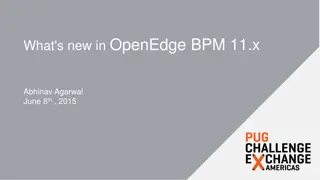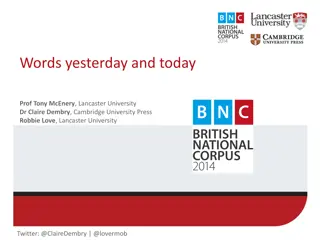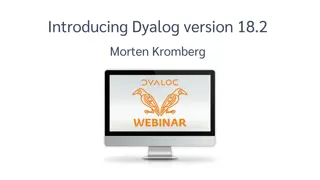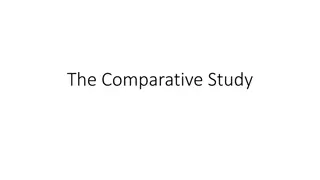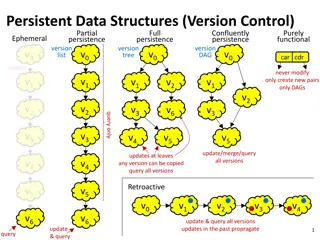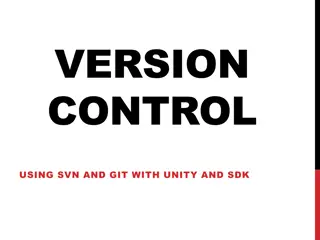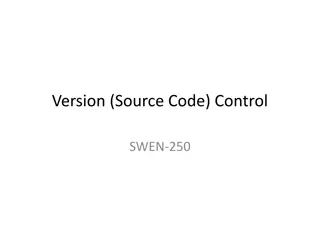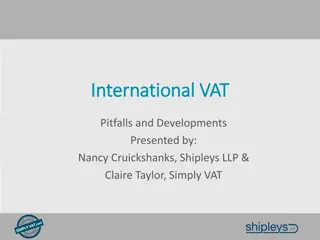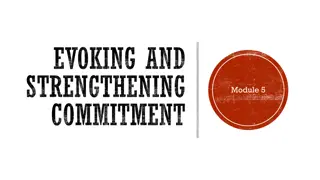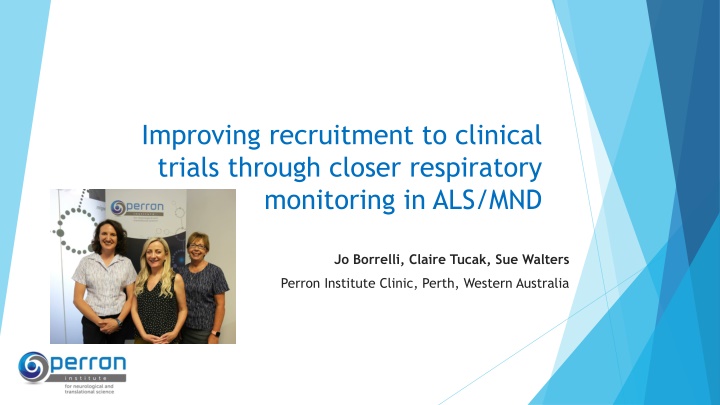
Enhancing Clinical Trial Recruitment with Respiratory Monitoring in ALS/MND
Learn how closer respiratory monitoring can improve recruitment in ALS/MND clinical trials, tackling challenges like eligibility criteria based on respiratory measurements and remote patient access. Explore a Phase 2 trial's insights and clinical questions on respiratory function monitoring.
Download Presentation

Please find below an Image/Link to download the presentation.
The content on the website is provided AS IS for your information and personal use only. It may not be sold, licensed, or shared on other websites without obtaining consent from the author. If you encounter any issues during the download, it is possible that the publisher has removed the file from their server.
You are allowed to download the files provided on this website for personal or commercial use, subject to the condition that they are used lawfully. All files are the property of their respective owners.
The content on the website is provided AS IS for your information and personal use only. It may not be sold, licensed, or shared on other websites without obtaining consent from the author.
E N D
Presentation Transcript
Improving recruitment to clinical trials through closer respiratory monitoring in ALS/MND Jo Borrelli, Claire Tucak, Sue Walters Perron Institute Clinic, Perth, Western Australia
Background Good recruitment is critical to the success of clinical trials Limited disease modifying options for people with MND should mean easier recruitment Eligibility for MND trials has been highly dependent on respiratory measurement; Patients often fail to meet eligibility criteria SVC not met
Problems with Recruitment Access to electronic health records Clinicians & researchers based at different sites Eligibility criteria Patients living in remote areas
Clinical Management of MND in WA Approximately 180 people living with MND in WA (MNDAWA 2019) 3 MND multidisciplinary team clinics in WA The method and frequency of respiratory testing varies across the 3 MND sites
Our Trial Phase 2 clinical drug trial - 450 MND patients required globally Our site agreed to enrol 8 patients 10 patients screened (Sept 2018- April 2019) 2 patients (20%) were eligible 8 patients failed to meet all eligibility criteria 6/8 patients failed on Slow Vital Capacity (SVC) criteria of 65-90%
Objective To increase clinical trial recruitment through close monitoring of respiratory function
Clinical Questions: Do we have a trajectory of respiratory deterioration in MND? What are the recommended procedures for monitoring respiratory function? How often is respiratory function measured in WA?
Monitoring respiratory function what is recommended? Routinely perform respiratory function tests (Forced Vital Capacity and where possible Sniff Nasal Inspiratory Pressure) in all MND/ALS patients in outpatient clinics Advised: As soon as diagnosis is made Ongoing routinely check for symptoms and signs of respiratory insufficiency . No specific frequency determined Propose measure every 3 months Any recommendations for monitoring frequency since then? Ref: Heffernan et al (2006)
Guidelines BMJ Best practice Monitoring for respiratory decline (FVC) is recommended every 3 months NICE guideline Respiratory function tests: As part of the initial assessment to diagnose MND forced vital capacity (FVC) or vital capacity (VC)[5]
Guidelines cont. A healthcare professional with appropriate competencies should perform the respiratory function tests every 2 3 months, although tests may be performed more or less often depending on: whether there are any symptoms and signs of respiratory impairment the rate of progression of MND the person's preference and circumstances. [2010, amended 2016] How does our current practice of clinical respiratory measurement in WA compare to these standards ?
What is current practice in WA? Site 1 Physiotherapist has access to portable spirometry device to use when required - as and when basis Otherwise, patients are reviewed approximately every 3-4 months at Respiratory Clinic Site 2 Patients reviewed approximately every 3-4 months at Respiratory Clinic Site 3 Patients reviewed approximately every 3-4 months at Respiratory Clinic
How do respiratory measures correlate? FVC ( Forced vital capacity) and SVC ( Slow Vital Capacity) Study in 2017 of consecutive patients with ALS and PLS from 2000-2014. Tests at baseline and 4 months. ( Pinto and Carvalho, 2017) FVC and SVC in sitting position Both FVC and SVC were strongly correlated at baseline and 4 months r =0.98 Mean decrease of FVC 2.15 % per month and SVC 2.08% per month Can we use this data to screen those borderline patients more regularly to improve their access to clinical trials? Ref: Pinto S and De Carvalho M. (2017)
Example based on evidence of respiratory decline Screening FVC 94% - too good for inclusion If we apply mean decrease of 2.15% per month then they are then eligible at 2 months. Ref: Pinto S and De Carvalho M. (2017)
Method Physiotherapist (PT) and & Speech Pathologist (SP) reviewed medical notes across 3 clinics between April & June 2019 to pre-screen potential patients PT/SP attended clinics to assess those patients identified as being close to but above 90% on recent respiratory measures- using portable spirometry device
Results 7 patients were identified as suitable All patients were assessed using portable SVC/FVC device We were unable to fulfil our enrolment goal. 4 patients were above 90%: 2 patients MET THE SVC CRITERIA however, the trial closed recruitment unexpectedly early! 1 had a SVC of 94% - decline of approx. 1% per 2 months on SVC 3 had a stable SVC result (close to 95%) 1 patient had an SVC of 59%.
So where to now? We can t change eligibility criteria for clinical trials BUT we can change our approach
Recommendations SVC as standard at MND clinic appointments Clinical trials patient database Earlier review of trial criteria Education for AHPs
Application of Recommendations Early tracking of SVC/FVC MND Database development Portable SVC assessment in clinics Earlier detection of respiratory compromise Education for MDT AHPs
References http://www.appliedclinicaltrialsonline.com/barriers-clinical-trial- recruitment-and-possible-solutions-stakeholder-survey https://bestpractice.bmj.com/topics/en-gb/330/monitoring Gul RB, Ali PA: (2010) Clinical trials: the challenge of recruitment and retention of participants.J Clin Nurs19(1 2):227 33. Heffernan C, Jenkinson C, Holmes T, Macleod H, Kinnear W, Oliver D, Leight N and Ampong M (2006) Management of respiration in MND/ALS patients: An evidence based review, Amyotrophic Lateral Sclerosis,7:1,5-15 Jenkins VA, Farewell D, Farewell V, Batt L, Wagstaff J, Langridge C, et al.: (2013) Teams Talking Trials: results of an RCT to improve the communication of cancer teams about treatment trials. Contemp Clin Trials ,35(1):43 51.
References cont. Magnus T, Beck M, Giess R, Puls I, Naumann M and Toyka K. (2002) Disease progression in Amyotrophic Lateral Sclerosis: Predictors of Survival. Muscle and Nerve 25:709-714. Motor Neurone Disease: assessment and management NICE guideline [NG42] Published date: February 2016 Last updated: July 2019 Pinto S and De Carvalho M. (2017) Correlation between Forced Vital Capacity and Slow Vital Capacity for the assessment of respiratory involvement in Amyotrophic Lateral Sclerosis: a prospective study. Amyotrophic Lateral Sclerosis and Frontotemporal Degeneration,18:86-91 Wilson E, (2014) Tips for Success Patient Recruitment in Clinical Trials. Quintiles.
Contact Details Jo Borrelli - Joanne.Borrelli@perron.uwa.edu.au Claire Tucak - Claire.Tucak@perron.uwa.edu.au Susan Walters - Susan.Walters@health.wa.gov.au Perron Clinic +61 8 6457 0200
SVC is not routinely measured at MND Clinics Access to electronic medical records is a problem consent issues as working across different health departments Barriers to recommendations Patients who don t attend regular clinics may miss out on regular testing and the opportunity to participate in trials There can often be a delay in receiving the eligibility criteria, which hinders our early planning Recruiting to clinical trials is not the main focus of MDT clinic

